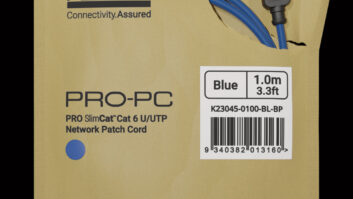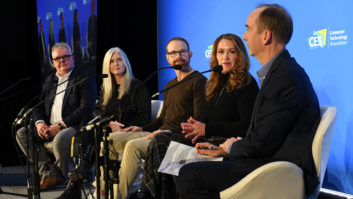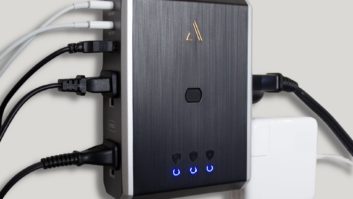Power management did not, initially, take the world of custom installation by storm. While early pioneers in the technology of surge protection and power regulation may have once had a tough time separating themselves from accusations of smoke-and-mirrors marketing hype, the category has grown significantly in recent years to become a near-necessity in high-end home theaters and multi-room AV systems.
The change did not come easy, and remains a challenge. It requires better education from product vendors, better buy-in from residential electronic systems contractors (RESCs), and growing understanding by consumers who want better performance and a desire to protect their investment in expensive electronics.
Progress Made
Panamax, on the consumer electronics side and Furman, on the musical instruments and pro audio side, were two of the first companies to tackle the power management category. While the now-combined companies (see sidebar) faced expected hurdles in their early years, Furman senior vice president of sales and marketing, Dave Keller, said that he has noticed that as more competitors joined the market, his company was better able to educate installers on why power management is so important to their customers.
With this raised awareness, more and more installers are now identifying power management as an essential piece to every installation, not only because of the performance and equipment longevity the products provide, but also because of their benefits to the installers bottom line, including increased profit margins from attachment products and reduced service calls, he said.
Monster CEO, Noel Lee, agreed that when company expanded from its cable products core into power management for the CI industry, not many installers knew about the importance of the category. However, his companys educational program, in addition to a growing concern by consumers about lightning storms and hurricanes has made power protection and power conditioning an accepted part of many custom installers vocation. We see that the awareness of power products and their importance has grown dramatically, although there is still plenty of room for more education on the higher-end products and their value.
Consumer understanding of power management has come a long way in the last 10 years, but it is still limited. It is, agreed Richard Grays Power Company (RGPC) president, Rick Komendera, a conscientious integrators responsibility to reduce or remove the threat of ground loops, surges, RF noise, and other power-related anomalies. Fortunately, he explained, more and more integrators are recognizing potential benefits to power management for both their customers systems as well as their companies bottom lines.
The rapid emergence of dedicated home theaters over the past 10 years has led to an increased demand for power products, Komendera said. A consumer willing to spend tens of thousands of dollars on a home theater is willing to invest a few thousand more to ensure the system is protected with the right amount of on-demand power available at all times.
Many of RGPCs more successful integrators live by the philosophy of top-lining power products on their recommended equipment lists, effectively arguing that the performance of all other gear is dependent on clean power. In most systems, Komendera explained, power management gear accounts for less than five percent of the total installation cost; many installers position the nominal power management cost to their customers as an insurance premium of sorts, he said.
The challenge remaining for integrators is remembering to not only sell all of the benefits that power management products can provide, but also making sure those features are utilized in a system. There is no doubt that in the past few years, most dealers and installers have learned (perhaps some the hard way) that the quality of the power supplied to the system dictates not only the quality of the sound and picture, but the overall life and survivability of the connected equipment, explained Tripp Lite executive VP, Jim Folk. I believe that most dealers and installers know that they need power management products in their systems, [but] that many of the finer features of the products offerings still go unused because the installer does not have the time, or perhaps the training, to take advantage of them.
Thats a point echoed by APC AV product line manager, Patrick Donovan, who has found that too much power conditioning marketing has focused on sound and video signal improvement, and not enough on protecting the customers investment. Plug this in and your experience will magically get better went the mantra. For many power vendors, he said, this still seems to be the message.
This is a very subjective benefit that many customers just wont see, frankly. Its a tough sell, Donovan noted. If your customer doesnt have serious electrical noise problems, then conditioning the power will have little to no effect on quality. APC believes that protecting the customers investment and eliminating interruptions in their experience of the system are much more concrete benefits that people can relate to and understand. They also are benefits that appeal a great deal to the installer themselves as this kind of protection can save them time and money by reducing service calls.
In the end, Donovan added, this approach helps improve or maintain good customer satisfaction, and that is critical in being successful against the mass retailers and other installers. I do believe that more systems are protected today than in the early days, but I also think there is still a lot of room for growth, he added.
Current Trends
As U.S. power grids become even more taxed and the power quality from the utility declines, the equipment in home theater systems is growing more advanced than ever and its sensitive circuitry more highly susceptible to AC irregularities. Furmans Keller noted that these trends not only affect the longevity of high-end components, but also can undermine their performance.
The developments in home theater video and audio have been truly remarkable, but it takes advanced power management to receive the full benefit of these technologies, he said. We are seeing an increasing need for our more advanced power management technologies, such as AC noise filtering, voltage regulation, and battery backup.
Tripp Lites Folk agreed that the continued convergence to a digital suite of products is requiring better power quality to the point where pure sine wave power is a requirement. Inherent in the digital solution is the ability to communicate, control, and monitor the power system in ways that have historically not been done, he said. Of course, this would not be possible without the IP addressability of power management products.
The trend toward multi-room or whole-house power solutions for AV management is another challenge facing manufacturers. Its one that RGPCs Komendera is attacking head on with new product development. Gone are the days when a system fit on one circuit. We developed a whole-house power management solution last year that serves all power conditioning, protection, and back-up needs directly from the AC panel, so there is no need for separate power management components in an over-crowded rack, he said.
Going Green
It would be impossible to address power management trends without noting the implications of the green movement, in general, and the U.S. energy crisis, in particular. Not all power management product manufacturers are talking about it, but they all likely will be in coming months or years, as federal and state laws change and consumers become more sensitive to energy costs and their personal carbon footprint.
APCs Donovan said that, without hesitation, the green movement is the biggest opportunity facing the power management category. One of the principal benefits of a power management product could certainly be to reduce your customers energy consumption, he said. I think customers will respond quite positively to this benefit out of a sense of civic duty or from a desire to save money…or both. In my view, custom installers need to embrace this trend to help them offer a clear value-add over the big-box stores.
As a product manager at APC, Donovan said, it will fall on his shoulders to develop products that offer a power-saving value. In addition to reducing customers overall energy consumption by smartly managing connected components, APC also plans to make its own products more efficient so that they consume less power.
Furmans Keller acknowledged that the home theater industry has historically been somewhat indulgent in environmental concerns, as a high-end home theater system is a luxury than can consume quite a bit of power. Power management products, he said, by virtue can help control power consumption, reduce vampire power, reduce electronics in the waste stream by extending the life of connected equipment, and can reduce service calls, and subsequent fuel use, by offering remote diagnostics through IP control. That said, it is every manufacturers responsibility to practice environmental consciousness, not only in the products they develop but in the way they run their businesses, Keller explained.
According to RGPCs Komendera, the green movement should not be viewed as a trend, but a change in consciousness that not only affects purchasing decisions but also is inspiring a whole cottage industry of products. It is clear that alternative sources of energy such as solar, wind, and water are the future, he explained. However, each of these sources represents an intermittent power supply that, in essence, can cloud over, stop blowing, or dry up at any time. Its necessary, then, to design power management systems that can back up and stabilize these alternative energy sources.
Komendera agreed that the power management industrys biggest contribution to the green movement is assisting in the monitor of electricity consumption. This is valuable for determining peak usage times and provides a tool that can help consumers adjust habits to reduce the amount of energy they use.
Several of our customers use the RGPC PowerVault for just such a purpose, Komendera pointed out. And with its help they are applying for myriad energy-related tax breaks that are available from local, state, and federal sources.
Remaining Challenges
Most power management product manufacturers cite education of integrators and consumers as their other big challenges. While education has helped power management gain favor with installers, it is a continual process with them and their clients.
All power management vendors must continue to educate the various channels and end users as to why they need power management products, said Furmans Keller. There are still dealers who dont sell power management or only sell inexpensive products that do not provide customers with maximum conditioning and protection. The reason for this is that if a dealer cant explain the technology of power management, or answer questions as to why it is important, they are going to shy away from the category altogether.
And while growing competition in the power category can be good thing for the industry, it has its negative side effects, said RGPCs Komendera. Its good because it reflects the realization among more companies that power management is an integral part of the AV installation equation. Its bad because some of the more esoteric new products make unsubstantiated claims about what they can do for a system.
This situation, Komendera noted, feeds the notion that power products are snake oil, which can have negative consequences with consumers and can negatively impact everyones business. Beyond that, he said, the biggest challenge is consistently standing out among the hundreds of power management products currently available.
Today, its more difficult than ever to gain market share when there are so many options for installers to choose, Komendera said. Thats why, in addition to our product benefits, we strive to focus on client satisfaction in every aspect of what we do. This philosophy manifests itself in sometimes-extraordinary ways. For example, weve actually over-nighted a 350-pound PowerHouse to make sure a dealers install was completed on time.
Jeremy J. Glowacki ([email protected]) serves as editorial director of New York City-based Residential Systems, out of his satellite office in Carmel, Indiana.







